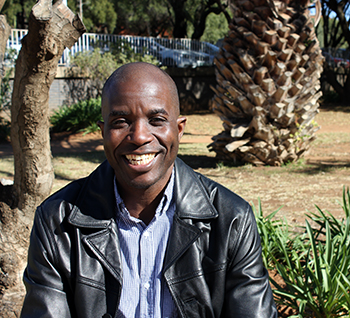Latest News Archive
Please select Category, Year, and then Month to display items
05 June 2018
Photo Supplied
 Archaeological excavations in the Wonderwerk Cave, north of Kuruman in the Northern Cape.
Archaeological excavations in the Wonderwerk Cave, north of Kuruman in the Northern Cape.
Research fellow Dr Lloyd Rossouw from the Department of Plant Sciences at the University of the Free State (UFS) recently published an article in the Nature Ecology and Evolution journal with Dr Michaela Ecker from the University of Toronto as lead author, and Dr James Brink, research fellow at the UFS Centre for Environmental Management. The findings described in “The palaeoecological context of the Oldowan-Acheulean in southern Africa” provides the first extensive paleoenvironmental sequence for the interior of southern Africa by applying a combination of methods for environmental reconstruction at Wonderwerk Cave, which have yielded multiple evidence of early human occupation dating back almost two million years ago.
Where water once was
The Wonderwerk Cave is found north of the Kuruman hills (situated in Northern Cape) a 140m long tube with a low ceiling. The surroundings are harsh. Semi-arid conditions allow for the survival of only hardy bushes, trees, and grasses. But during the Early Pleistocene, stepping out of the Wonderwerk Cave you would have been greeted by a completely different site, the researchers found. Using carbon and oxygen stable isotope analysis on the teeth of herbivores (Dr Ecker), fossil faunal abundance (Dr Brink), as well as the analysis of microscopic plant silica remains (phytoliths) excavated from fossil soils inside the cave (Dr Rossouw), the results show that ancient environments in the central interior of southern Africa were significantly wetter and housed a plant community unlike any other in the modern African savanna.
What difference does it make?
While East African research shows increasing aridity and the spread of summer-rainfall grasslands more than a million years ago, the results from this study indicate an interesting twist. During the same period, shifts in rainfall seasonality allowed for alternating summer and winter-rainfall grass occurrences coupled with prolonged wetlands, that remained major components of Early Pleistocene (more or less the period between one and two million years ago) environments in the central interior of southern Africa. That means our human ancestors were also living and evolving in environments other than the generally accepted open, arid grassland model.
Game farming a lens to analyse challenges facing democratic SA – Dr Kamuti
2017-05-30

Dr Tariro Kamuti, Postdoctoral Fellow at the Centre
for Africa Studies at the University of the Free State.
Photo: Rulanzen Martin
One of the challenges facing South Africa’s developing game farming policy is the fractured state in the governance of the private game farming sector, says Dr Tariro Kamuti.
Dr Kamuti, a Postdoctoral Research Fellow at the Centre for Africa Studies (CAS) at the University of the Free State (UFS), was presenting a seminar on Wednesday 17 May 2017 under the topic, Private Wildlife Governance in a Context of Radical Uncertainty: Challenges of South Africa’s Developing Game Farming Policy, which takes material from his PhD. He received his PhD from both the Vrije University in Amsterdam and the UFS in 2016.
His presentation explored how the private game industry positions itself in accordance with existing agricultural and environmental regulations. It also investigated the state’s response to the challenge of competing needs over land and wildlife resources which is posed by the gaming sector. “The transformation of the institutional processes mediating governance of the private game farming sector has been a long and enduring arrangement emerging organically over time,” Dr Kamuti said.
Game farming links wildlife and agricultural sectors
“I decided on this topic to highlight that game farming links the wildlife sector (associated with conservation and tourism) and the agricultural sector. Both make use of land whose resources need to be sustainably utilised to meet a broad spectrum of needs for the diverse South African population.
“The continuous skewed ownership of land post-1994 justifies questioning of the role of the state in confronting challenges of social justice and transformation within the economy.”
“Game farming can thus be viewed as a lens through which to study the broad challenges facing a democratic South Africa, and to interrogate the regulatory and policy framework in the agricultural and wildlife sectors at their interface,” Dr Kamuti said.
Challenges facing game farming policies
The state alone does not apply itself to the regulation of private gaming as a sector. “There is no clear direction on the position of private game farming at the interface of environmental and agricultural regulations, hence game farmers take advantage of loopholes in these institutional arrangements to forge ahead,” Dr Kamuti said.
He further went on to say that the state lacked a coherent plan for the South African countryside, “as shown by the outstanding land restitution and labour tenant claims on privately owned land earmarked for wildlife production”.
The South African government was confronted with a context in which the status quo of the prosperity of the middle classes under neoliberal policies was pitted against the urgent need to improve the material well-being of the majority poor. Unless such issues were addressed, this necessarily undermined democracy as a participatory social force, Dr Kamuti said.